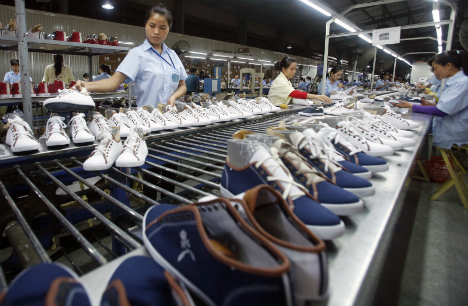
Bangladesh and Vietnam are on the list of seven largest apparel exporters to Russia. Source: Reuters
Since the beginning of 2015, the Russian clothing and footwear retail market declined by 25–35 percent in terms of volume. It is, however, expected to grow at about 3.5–4 percent by the end of the year in terms of value to reach 3.21 trillion rubles ($60.9 billion), according to Y-Сonsulting analysts’ estimates. In the first quarter of 2015, sales declined by 42 percent in terms of volume and 19 percent in value terms. The mid-range segment has experienced the most severe drop.
Since 2014, many international clothing brands left the Russian market, including Italy’s OVS, British New Look and River Island, and Germany and Hong Kong headquartered Esprit. Experts predict a new wave of exits in September-October.
Import trends shifting
The Asian garment manufacturing industry is undergoing a certain kind of segmentation, according to experts. China’s position as world’s number one destination for cheap textiles has been shaken by emerging Asian counties such as India, Bangladesh, Vietnam, Thailand, and Indonesia.
According to the Vietnam Textile & Apparel Association (VITAS), between 2005 and 2011, the country’s garment exports increased by 32 percent, while China's exports increased by 15 percent and exports from India, Turkey, Malaysia and Thailand increased by about 7 percent.
“Textile and footwear production gradually leaves China. Countries such as India, Bangladesh, Pakistan and up to lesser extent Vietnam, Cambodia, Indonesia, Laos, Korea have significantly developed their garment manufacturing industries,” Olga Strelnikova, head of textile department at SCS Group, says.
There are two major factors that make garment imports to Russia from these counties more competitive than from China, - the prices and the lower import duties imposed by the Russian government.
“Speaking of import growth in 2013-14, one may see an obvious trend. The negative dynamics of China, Italy and Turkey and growing figures for Vietnam, India and Bangladesh,” Anna Lebsak-Kleimans, CEO Fashion Consulting Group, says.
Bangladesh and Vietnam are on the list of seven largest apparel exporters to Russia, according to on Consulting Group data. Although their shares are not as big as China’s, the growth is more impressive. In 2012-14, imports from Bangladesh grew at 25.59 percent and Vietnam at 16.96 per cent while imports from China fell by 4.48 percent.
Anna Lebsak-Kleimans notes that Asian countries, mainly China, account for about 75-80 percent of counterfeit garment and footwear imports in Russia (the so-called “grey import”). At the same time, the size of this segment has reduced significantly since 2000 when it was estimated at about 80 percent of total sales, Lebsak-Kleimans says. In 2014, it accounted for not more than 25 percent. The segment affected by counterfeit goods is mostly bags and accessories, sportswear and shoes (Adidas, Nike, and others).
Vietnam at the forefront
According to the Vietnam National Textile and Garment Group (Vinatex), the European Union will continue to be Vietnam’s major market in the coming years. However, with Moscow no longer levying high tariffs on Vietnamese apparel products, its exports to Russia will increase.
Last week, Vietnam signed a free trade agreement with the Eurasian Economic Union (EAEU) comprising Russia, Belarus, Armenia, Kazakhstan and Kyrgyzstan. This is likely to boost apparel exports from Vietnam to the EAEU.
“Implementation of the agreement will boost bilateral trade and promote trade and economic ties between its participants, it will also solve the problem of involving the EAEU in integration processes in the Asia-Pacific region,” a Russian government press statement said.
Russian authorities expect this agreement to become a model for Russia’s further integration with other members of ASEAN trade bloc.
“Creating a free trade zone will benefit Vietnam whose export-oriented economy has been already showing good growth rates since 2011. It will provide Vietnam with some logistic advantages over its Asian peers, for example Bangladesh,” Anna Lebsak-Kleimans says. At the same time, she adds, the emergence of a new “low-cost” provider of finished garment products will further complicate the task of bringing industrial enterprises back from Asia to Russia.
“The share of imports in clothing, footwear and accessories segment is more than 80 percent. The fall in local garment manufacturing has been continuing for the last 20 years and it is very difficult to reverse it,” she says.
The article is abridged. Read the full version at Asia.RBTH.com.
All rights reserved by Rossiyskaya Gazeta.
Subscribe
to our newsletter!
Get the week's best stories straight to your inbox